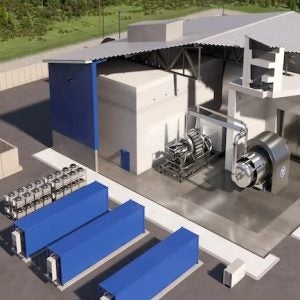
The submission was made soon after NRC staff decided on 28 February to begin using a streamlined process for reviewing the environmental impacts of advanced reactors by developing a generic environmental impact statement. This process is expected to reduce the length of the approval process by 25%.
The "generic" statement means that the NRC can to use a "technology-neutral" approach to determine many of the environmental impacts from a proposed reactor.
For example, a proposed reactor will have a certain site area, and the NRC staff would judge the land and water use impacts of the proposed reactor based on a generic plant of the same size. This will save resources that would otherwise be spent on "duplicative review”, NRC said. Developing the generic environmental impact statement will take around 24 months.
Caroline Cochran Oklo's chief operating officer and co-foundersaid that is appropriate for regulators to look at the "general" impacts of a small plant such as the Aurora, which would have the square footage of a "large home,"
The new process applies only to reactors that can generate up to 30MW thermal, which includes Oklo's Aurora design, but excludes many of the other advanced reactors that have been proposed for the USA.
Oklo said its application is a "landmark milestone" in the development of advanced fission technologies. In addition to being the first application for an advanced reactor, Oklo pioneered the novel application structure.
Oklo’s application is also the first privately-funded for a commercial advanced reactor.
The application received a positive response from US Assistant Secretary for Nuclear Energy Rita Baranwal, who said the company’s “micro-reactor design is the first non-light water advanced reactor to enter the (NRC) review process, which will help pave the way for future developers”.
Oklo began pre-application for Aurora with the NRC in 2016. In 2018 it piloted the new application structure, which was “completed interactively with NRC review and feedback to drive efficiency and effectiveness for future applications”.
“We are excited to show that an application for a fundamentally different fission technology can meet and exceed existing regulations while not being impeded by guidance based on nuclear plants of decades ago,” Cochran said.
Oklo’s director of licensing, Alex Renner said, “This is not just a big step for Oklo. This licence application is a significant step towards deploying advanced fission energy and starting the clean energy revolution for the sake of humanity and the environment.”
Speeding up advanced reactor development
The nuclear industry and members of Congress had urged the NRC to speed up the review for advanced reactors. A bill signed into law by US president Donald Trump at the end of 2019 ordered NRC to create a new regulatory structure for advanced reactors, and the Nuclear Energy Institute said NRC should move ahead with a generic environmental impact statement.
Oklo's Aurora “advanced fission power system” is designed to generate approximately 1.5MWe comprising a small reactor with integrated solar panels. It will use metal fuel to produce heat, which will pass through a heat exchanger and be converted into electricity.
The company Aurora will generate usable heat and electricity, run for at least two decades on a single load of fuel and operate without the need for water. The plant can also convert nuclear waste to energy. Oklo said the Aurora could be used as an alternative to a diesel generator, saving a million tons of carbon dioxide emissions over its lifespan compared with burning diesel.
Oklo previously received federal cost-shared funding for technology development through the US Department of Energy's (DOE’s) cost-shared Gateway for Accelerated Innovation in Nuclear initiative. In December, it received a site use permit from the DOE to build an Aurora plant at Idaho National Laboratory (INL) – the first-of-a-kind deployment of the design.
Earlier this year, INL announced that it would provide Oklo with access to HALEU fuel recovered from used fuel from the now-decommissioned Experimental Breeder Reactor-II.
HALEU, which contains between 5% and 20% uranium-235, has many advantages that improve reactor performance. Because U-235 is more concentrated, the fuel assemblies and reactors can be smaller and achieve higher burnup rates, which means less fuel may be required.
NRC said it is not trying to address "the entire breadth of advanced reactor sizes and technologies” using the new process, which is why the generic environmental impact statement will apply only to small reactors. However the environmental reviews "could be expanded to encompass some categories of larger advanced reactors as more information on new technologies becomes available”.
Photo: Oklo representatives with the U.S. Nuclear Regulatory Commission staff and the Nuclear Reactor Regulation management team. (Photo: Oklo Inc.)






